How to dual boot Windows 11 and Windows 10
With a dual-boot system, you can install Windows 11 on a Windows 10 PC. This allows you to test out the new operating system from Microsoft without having to uninstall the existing operating system.
Setting up a Windows dual-boot system is pretty easy. All you need is a Windows 11 compatible system, ISO image, enough storage space and a few minutes. Consider two ways to dual boot Windows 11 with Windows 10 in the article below.
Conditions for dual booting Windows 11 with Windows 10
You need a little preparation before you can dual boot Windows 11. First of all, you must have a computer that can run Windows 11. This is easier said than done, because the system requirements to run Windows 11 are high. a little more than one would expect.
If your PC can run Windows 11, download the Windows 11 ISO image and create a bootable USB. If you don't have a USB, you can mount ISO image files.
Where can Windows 11 be installed on a Windows 10 PC?
You can shrink an existing volume and create a new partition on the drive to install Windows 11. The article will guide you through the necessary steps to shrink, format and create a new partition.
Method 1: Dual boot Windows 10 and Windows 11 from within
You can install Windows 11 by running the setup.exe file directly from the Windows Source folder. This is useful if you don't have a bootable USB. This method involves many steps, so follow what is necessary in your case.
Step 1: Shrink volume or partition
First, shrink the current partition to create another partition large enough for the Windows 11 installation. To do this, press Win + R to open Run. Next, type diskmgmt.msc and click OK to open the Disk Management tool.
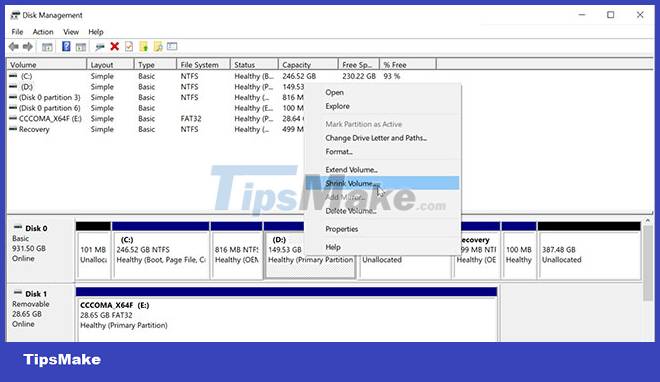
In the Disk section, right-click any drive with enough free space and select Shrink Volume.
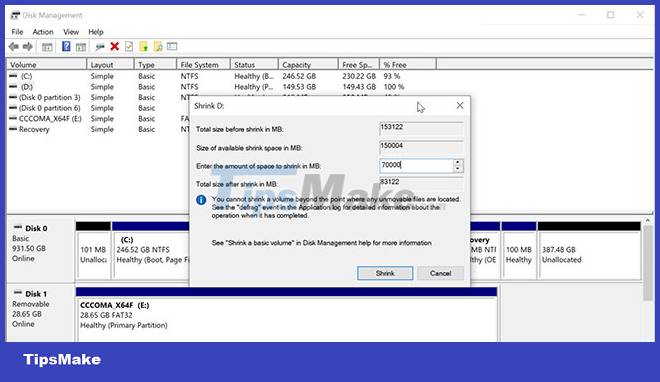
In the dialog box that appears, enter the amount of space to shrink in MB and click Shrink. For example, if your current volume has 153122MB (150GB) free space, enter 70000 in the Shrink field. It will shrink your current volume down to 80GB and the remaining 70GB will show up as unallocated space.
Step 2: Create a new volume
To create a new volume, right-click on the unallocated space and select New Simple Volume.
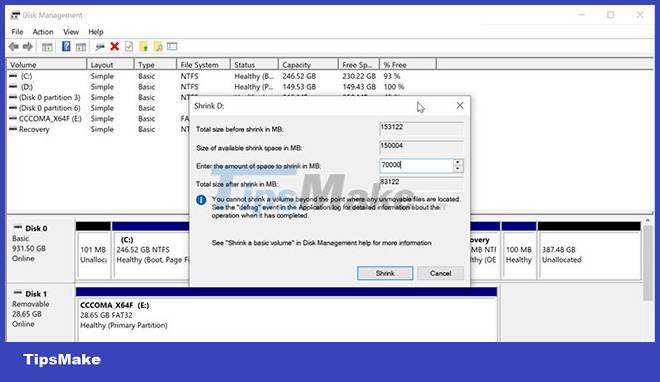
In the New Simple Volume Wizard window, click Next. Then enter the size for the new volume and click Next. Make sure you allocate enough space to install Windows 11.
Select the Assign the following drive letter option and click Next.
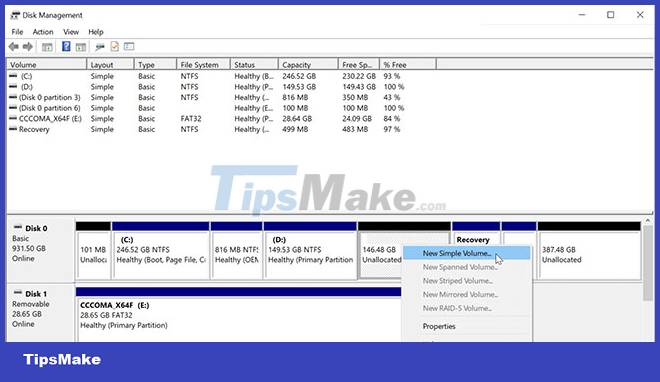
Next, check Format this volume with the following settings and select the following:
- File System - NTFS
- Allocation unit size - Default
- Volume Label - Windows 11
Labeling the volume will help you easily identify the drive during installation. Also, select the option Perform a quick format. Finally, click Finish to create a new partition.
Step 3: Install Windows 11 with Windows 10
Connect the Windows 11 bootable USB to the PC. If you don't have a bootable USB, mount the Windows 11 ISO image.
To do this, right-click on the ISO image and select Mount. After you have mounted the image, it will appear as a new drive in This PC.
Next, open the USB boot or mounted ISO in File Explorer. Then, open the Sources folder and run the setup.exe file. Click Yes when prompted by UAC (User Account Control).
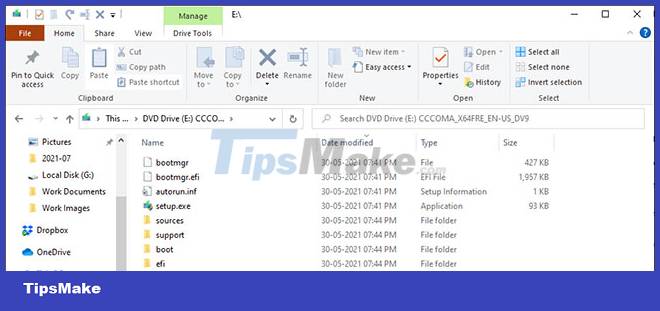
In the Windows Setup screen, select No thanks to continue. Next, accept the applicable license notices and terms, and then click Next.
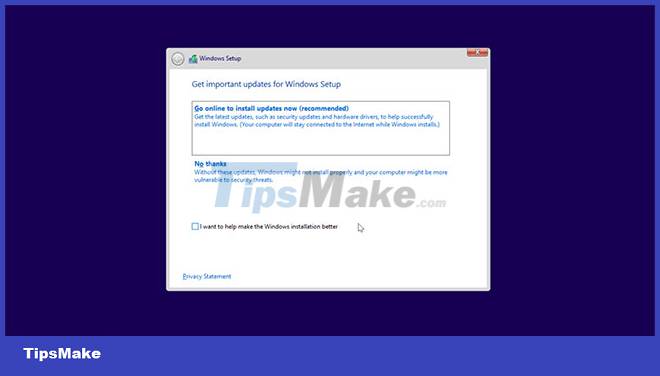
Select the Custom option: Install Windows only (advanced). In the Where do you want to install Windows screen, select the Windows 11 volume and click Next.
Windows 11 will now begin the installation. This process can take some time and longer on traditional hard drives.
During the installation, your PC will reboot and show Windows Boot Manager. Here, select the first Windows 10/11 Setup option to continue with the setup.
Once the setup is done, reboot your PC and you should see a dual boot option in Boot Manager.
Method 2: Dual boot Windows 11 with Windows 10 using the boot drive at startup
If you want, you can also install Windows 11 at boot with the boot drive. Here's how to do it.
First, follow step 1 in method 1 to shrink a volume on the drive, creating unallocated space. Once you have enough unallocated space to install Windows 11, proceed with the installation.
Step 1. Turn off the PC and connect the USB boot.
Step 2. While restarting the PC, start pressing F12 to access the Boot menu.
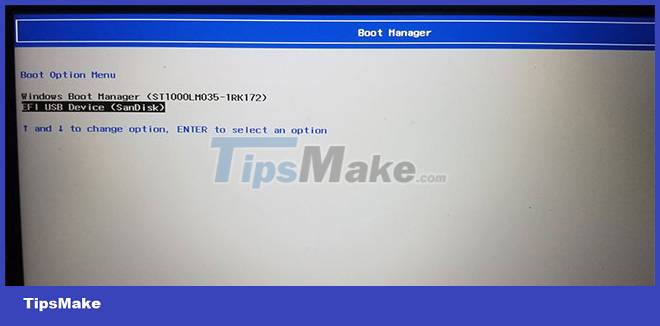
Step 3. Select the Windows 11 boot drive as the boot device in Boot Manager.
Step 4. In the Setup window, select the language and other options, and then click OK.
Step 5. Next, click Install Now and accept the license terms.
Step 6. Select the Custom option: Install Windows only.
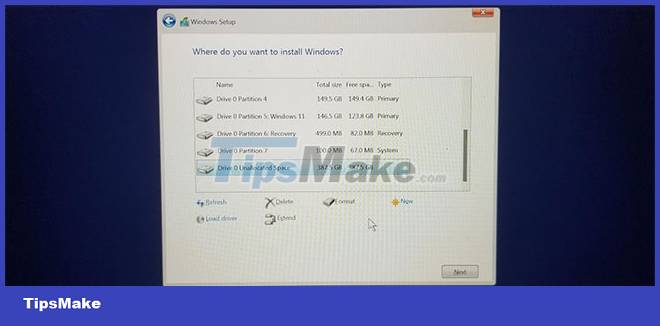
Step 7. In the Where do you want to install Windows screen, select Unallocated space partition and click Next.
Windows 11 will start installing on your selected partition. Follow the setup steps to complete the installation. Once installed, your device will automatically set Windows 11 as the default operating system.
How to choose the default operating system to boot between Windows 10 and 11
You can change the default operating system to boot on a dual-boot system from Startup and Recovery. Here's how to do it.
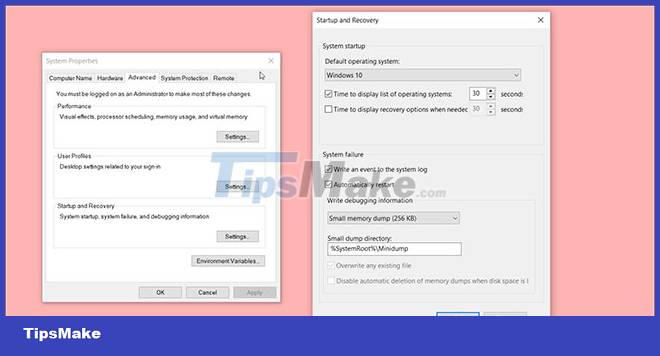
Step 1. Press Win + I to open Settings.
Step 2. Go to System and then open the About tab from the left pane.
Step 3. In the right pane, click Advanced System Settings under Related Settings.
Step 4. In the Startup and Recovery section, click Settings.
Step 5. Click the Default operating system drop-down menu and select your preferred operating system.
Step 6. Set the Time to display list of operating systems and Time to display recovery options when needed options to 30 seconds each.
Step 7. Click OK to save the changes and restart the PC.
During reboot, the system will prompt you to choose your preferred operating system to boot from. If you do not select any, it will automatically start the default operating system. If you still don't see dual boot options during reboot, try disabling Fast Startup.
The dual boot feature is useful if you want to try out Windows 11 without worrying about its performance and stability issues. However, dual booting is not without its flaws. There are risks and issues that can affect system performance. Knowing the potential dual-boot problems can help you minimize their impact.
You should read it
- How to create dual boot Linux and Windows 10 on Linux
- Use parallel Windows 7 and Windows 8 on PC
- Create dual-boot menu after installing Windows XP parallel Vista / 7
- How to install dual boot Windows 10 and Windows Server
- Advantages and disadvantages of dual boot (dual boot)
- Will dual-boot options be added soon with Windows 10?
 How to update drivers for windows 10 with 3 ways
How to update drivers for windows 10 with 3 ways How to Change Color Saturation on Windows 10
How to Change Color Saturation on Windows 10 How to create Slide to Shutdown function on Windows 10
How to create Slide to Shutdown function on Windows 10 Steps to customize Sleep mode settings on Windows 10
Steps to customize Sleep mode settings on Windows 10 3 ways to turn off the Windows 10 firewall, steps to turn off the firewall on Windows 10
3 ways to turn off the Windows 10 firewall, steps to turn off the firewall on Windows 10